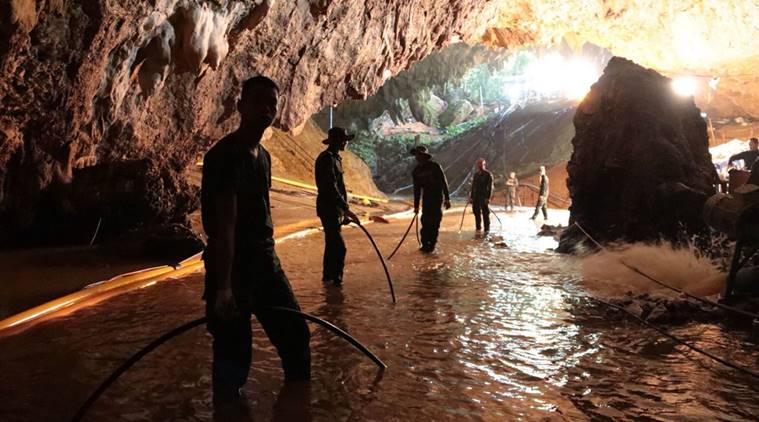
If you have read the news at all lately you’ve heard the harrowing tale of 12 young boys and their soccer coach who are trapped in a cave in northern Thailand. (UPDATE – As of Monday expert rescue divers had shepherded four of the boys to safety)
The kids, ages 11 to 16, have been stuck for two weeks, and a series of efforts are underway to rescue them before the monsoon season begins in full force. The heavy rains will flood the caves and potentially shut the kids off until October, creating a situation of prolonged anxiety for the parents that seems completely unbearable. According to a CNN report, the parents of 11-year-old Chanin Viboonrungruang, the youngest of the trapped boys, “keep a constant vigil…at the site of the cave.”
Last Friday a Thai Navy SEAL diver helping with the rescue effort perished, a turn of events that certainly could not have helped the mental state of these parents. “I’m afraid that the parents will begin to think the same thing will happen to their son,” said one local official.
This sort of anxiety is something us here at Digital Dying come across often when it comes to stories of loved ones lost or trapped in natural disasters, whether it be a flood, earthquake, hurricane or tornado. These events, as well as others that have become common in our modern world, like that of a hostage or active shooter situation, thrust those loved ones connected to the trapped victims into an uneasy state of limbo. Do we throw in the towel and start planning for a funeral, or hope for survival?
Of course, human nature entails that we almost always do the latter. But our society has certainly acknowledged the anxiety involved with waiting on news of a loved one missing or stuck in a disaster situation, as evident in things like the function on Facebook that allows survivors to check in after a disaster or shooting. Our modern world and its modern medicine may have come a long way in helping many people live longer and happier lives, but natural disasters that we cannot fully prevent still strike regularly, and humans are still inspired to explore stunning natural wonders that are often latent with hidden dangers, such as the caves in northern Thailand. We place ourselves in perilous situations, or they come and find us. The biting part of grief for those on the outside can often be that there is nothing concrete one can do to alleviate the situation and help bring their loved one to safety.
“Grief is a very personal reaction to these kinds of traumatic, life-altering events made worse by feeling like we have no control over anything in our lives,” writes psychologist John M. Grohol, on the site PsychCentral. “It’s the loss of security and the sense of stability that can be the most devastating.”
There is a roller coaster of human emotions involved for the loved ones looking on, especially when the situation goes from one where hope still remains, to one where all hope has been vanquished. All the while there is the thought of regret, that one could have perhaps done something different to prevent the event from happening or prevent the person from ending up in the perilous situation. “Do not hold yourself responsible for the disastrous event or be frustrated because you feel you cannot help directly in the rescue work,” says a webpage of the Federal Emergency Management Agency, or FEMA, on coping with disasters.
The FEMA webpage gives tips on ways the anxious family can try and handle their anxiety: “Maintain a normal family and daily routine, limiting demanding responsibilities on yourself and your family… Take steps to promote your own physical and emotional healing by healthy eating, rest, exercise, relaxation, and meditation.”
It might seem simple, but this is powerful advice and a reminder that grief is not something unique to our complicated gadget-filled modern world. Grief has ancient roots, and thus ancient cures too. Meditation is exactly what many people are participating in outside Mae Sai cave, where the boys are trapped, including a group of Buddhist monks that hold nightly vigils. They are joined by a stream of people from nearby villages, family and friends of the trapped boys, and a growing team of reporters and rescuers.
This isn’t the first time a crowd has gathered for a cave rescue. On January 30, 1925, while trying to find a new entrance to a cave in Kentucky, the famous American cave explorer William Floyd Collins became trapped in a narrow crawlway, some 55 feet below ground. The rescue attempt became one of the biggest media events of the era, drawing newspapermen, some of the world’s first radio reporters, and a crowd that at one point reportedly numbered in the thousands and included vendors who set up stalls to sell food and souvenirs. This may well be the other end of grief; spectacle. As the world leans in to follow the traumatic story, we must ask ourselves if our attention is truly helping the situation or only making matters worse. Media attention can help bring more necessary rescue resources to the situation, but it can also help to unnecessarily put additional lives at risk. In the end, having the world watching did not help the cause of William Floyd Collins.
“After four days, during which time rescuers were able to bring water and food to Collins, a rock collapse in the cave closed the entrance passageway, stranding him in the cave, except for voice contact, for more than two weeks,” reads his Wikipedia entry. “Collins died of thirst and hunger compounded by exposure through hypothermia after being isolated for 14 days, just three days before a rescue shaft reached his position.”
Grief itself may not have changed much over the years, but there is at least one big difference between the case of William Floyd Collins and the present situation with the boys in Thailand, and that is social media. The boys apparently have access to Facebook, or at least have been able to relay messages through other people.
“In a joint letter from the missing children posted to the Facebook page of the Thai Navy Seals on Saturday,” the CNN article explained, “the boys attempted to reassure their parents that they are OK and will be out soon.”
With a rescue operation now in place, this may indeed prove to be true.









